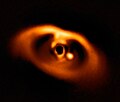| Subject | PI | Institution | Description | Notes |
|---|
| Planetary formation and properties | James Graham | University of California, Berkeley
Stanford University | "Exoplanets Unveiled"; Direct imaging, Doppler and transit methods, using the Gemini Planet Imager of the Gemini South Telescope, the Keck Observatory, and the proposed Thirty Meter Telescope. | [14] [15] [16] |
| Stellar proximity and Earth-like planet formation | Daniel Apai | University of Arizona | "Earths in Other Solar Systems"; development of computer model; Large Binocular Telescope | [17] [18] |
| Planetary formation | Eric Ford | Penn State University | Statistical models applied to Kepler data | [19] |
| Atmospheres of Hot Jupiters | Jason Wright | Penn State University | Diffuser-assisted photometry using ground based observatories | [19] |
| Chemistry of planetary atmospheres | Hiroshi Imanaka | SETI Institute | Habitable zones; atmosphere of Titan as an analogue to exoplanet atmospheres | [20] |
| Geochemical cycle of exoplanets | Steven Desch | Arizona State University | "Periodic Table of Planets"; geochemical modeling | [21] |
| Atmospheres of exoplanets | Drake Deming | University of Maryland | Analysis of Kepler data to study exoplanet atmospheres | [22] |
| Atmospheric evolution | William B. Moore | Hampton University | "Living, Breathing Planet". Determine past habitability of planets in the Solar System and apply results to exoplanetary habitability | [23] [24] |
| Atmospheric structure and spectra of exoplanets | Jonathan Fortney | University of California, Santa Cruz | New tools to analyze exoplanet transmission spectra to identify molecular features in the atmosphere | [25] |
| Planetary formation and evolution | Hannah Jang-Condell | University of Wyoming | Modeling planet formation, focusing on transitional, protostellar disks | [26] [27] |
| Formation of exoplanets | Neal Turner | Jet Propulsion Laboratory | Computer modeling of exoplanet formation | [22] |
| Exoplanet exospheres | Adam Jensen | University of Nebraska-Kearney | Detection and evolution of exospheres | [28] |
| Habitable exoplanets | Victoria Meadows | University of Washington | Virtual Planetary Laboratory (VPL) | [10] [29] |
| Planetary surface habitability | Anthony Del Genio | Goddard Institute for Space Studies | Planet simulation using the GISS Earth global climate model | [30] |
| Tidal dynamics and orbital evolution of terrestrial exoplanets | Wade Henning | University of Maryland, College Park
Goddard Space Flight Center | Study of how tidal heating can prevent the ejection of young, Earth-sized planets | [19] [31] |
| Detection of Earth-size exoplanets | Debra Fischer | Yale University | Design new spectrometer to detect Earth-size exoplanets; improve access to citizen science with Planet Hunters | [32] |
|


